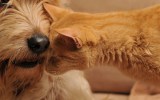
From a numbat joey learning to jump for the first time to an orca leaping out of the ocean with prey dangling from her mouth, the shortlisted images in the Australian Geographic Nature Photographer of the Year competition capture the beauty and breadth of the natural world.
Open to photos taken across Australia, New Zealand, Antarctica and New Guinea, the 2025 competition attracted 1864 images from 449 photographers in 18 countries, with the judges whittling these down to a shortlist of 99.
The top prize of $10,000 and a cruise was won by Western Australian photographer Ross Gudgeon for Fractal Forest, an underwater macro photo that looks more like a psychedelic painting.
Captured in Lembeh Strait, off North Sulawesi in Indonesia, Gudgeon’s image shows a cauliflower soft coral – so named because of its resemblance to the cruciferous vegetable.

The photographer was diving at North Sulawesi when he found himself surrounded by the coral, which he said aren’t very photogenic from the outside because “they just look like lumps of red cauliflower”.
“I carefully threaded the end of the extended macro wide lens through the branches of the soft coral so as not to damage them to take an image looking from the inside out,” Gudgeon said.
“After some trial and error and with backlighting from my strobes I was able to produce my winning image.
“The moral of my story is that beauty can be found anywhere.”
Judge Scott Portelli said the unique macro perspective of Fractal Forest enabled viewers to enter an “ethereal realm”.
“It shows an environment that few people see, presented in such a stunning way.”
The Australian Geographic Nature Photographer of the Year Competition, produced by the South Australian Museum, invites entries across 10 categories, including animals in nature, aerial, macro, landscape, our impact and threatened species.
South Australian Isabella Rogers won the junior category with a photo of two galahs perched on a lamp post at dawn, while Charles Davis of NSW took out animals in nature with PJ & Crabs, an image of a Port Jackson shark cruising over the top of thousands of spider crabs in Port Phillip Bay, Victoria.
Marsupials feature strongly across several categories, including another photo by Davis of a quoll taking a leap on a trail in Tasmania, and Tim Nallipogu’s Leaping for Joy, showing a young numbat learning to jump in Western Australia’s Dryandra Woodlands.

But when it comes to heartwarming, it’s hard to beat Too Cold Out, in which Victorian photographer Nicholas Cullen captured a penguin parent and chick at Auster Rookery, near Mawson Station in Antarctica.
“Surviving birth in the harshest environment on Earth is no easy feat,” Cullen writes in the notes accompanying his photo.
“A devoted parent cradles its chick on its feet, nestled in the warmth of a brood pouch. Yet, like any other day, this curious penguin waddled over, chick in tow, to investigate why I was lying on the ice.”
Shortlisted photos are on show at the South Australian Museum until February 1, and can also be seen in an online gallery.
A selection of the shortlisted images:


















